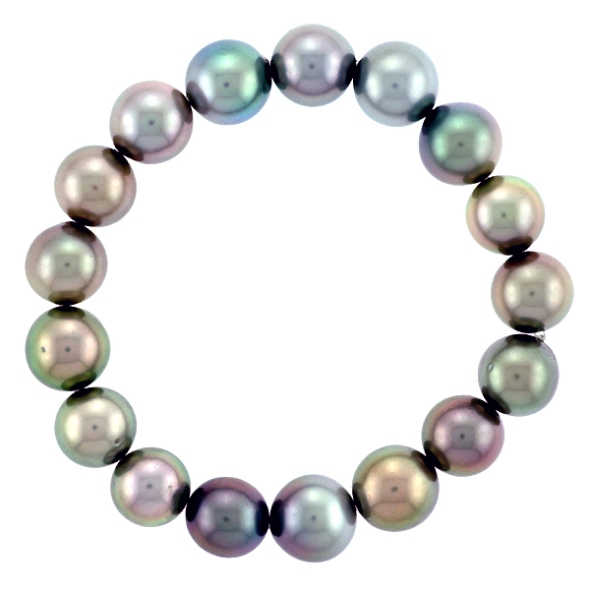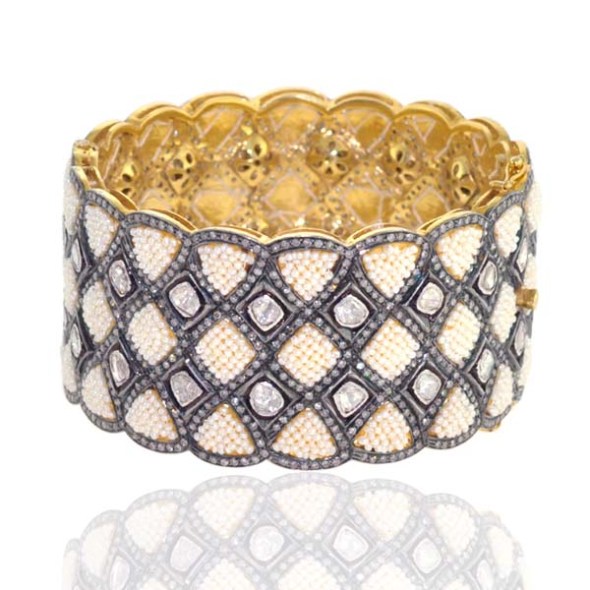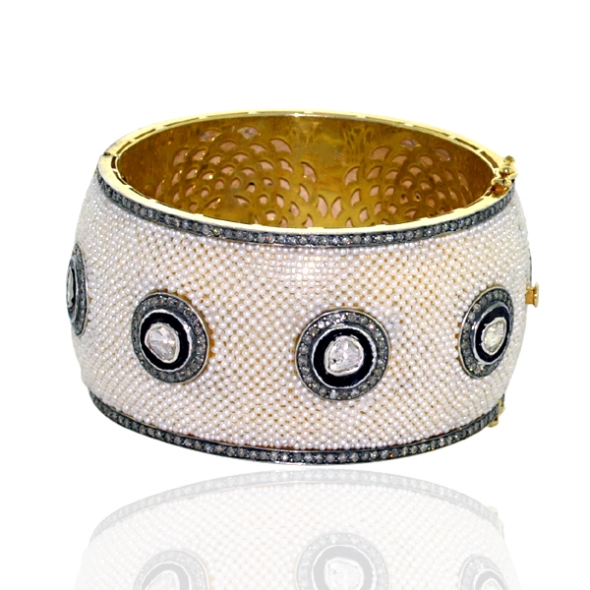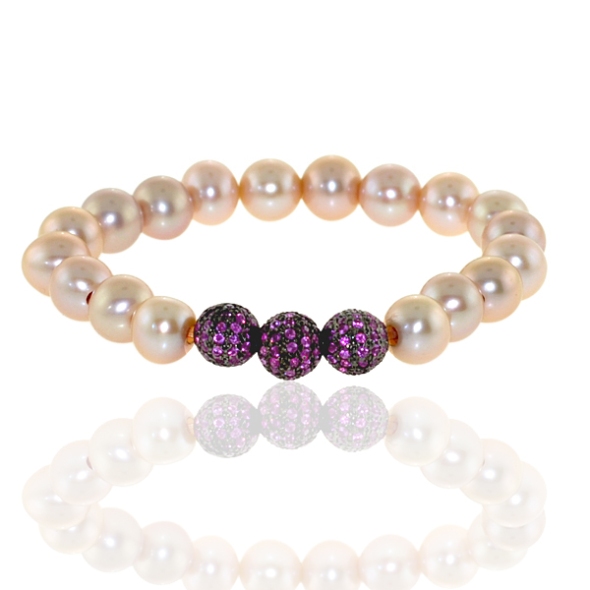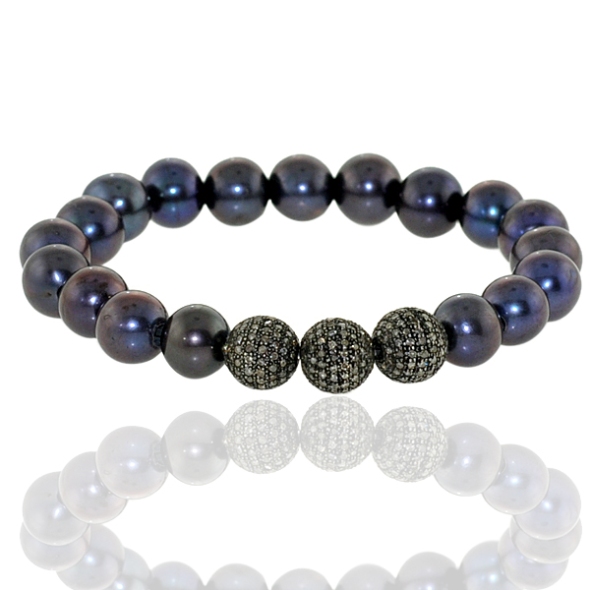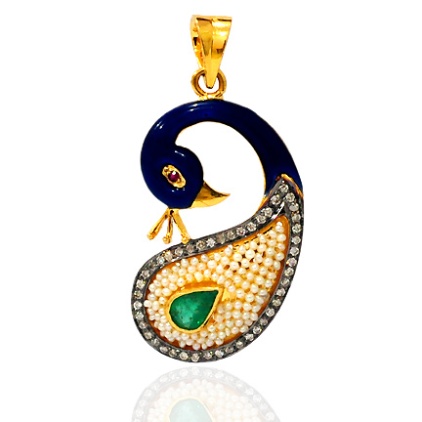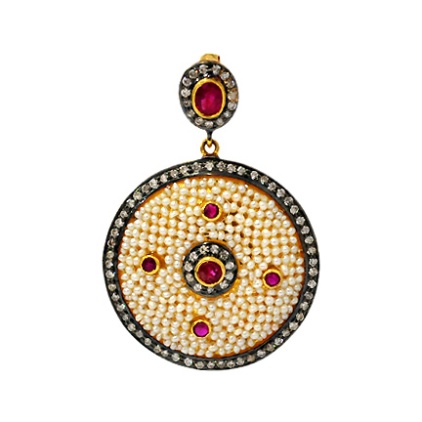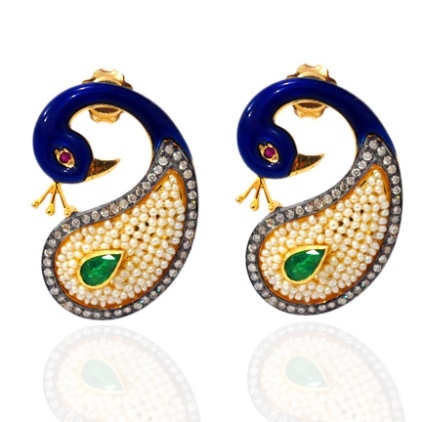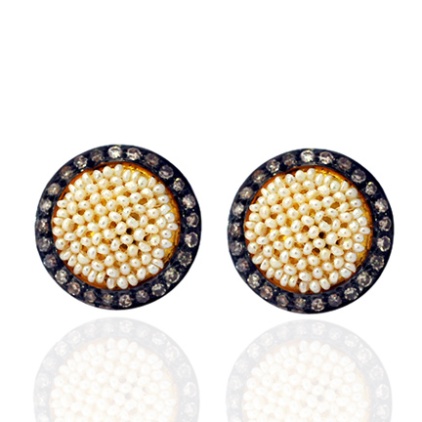Pearl
Many thousands of years ago, long before written history, human beings probably discovered the first pearl while searching the seashore for food. Throughout history, the pearl, with its warm inner glow and shimmering iridescence, has been one of the most highly prized and sought-after gems. Countless references to the pearl can be found in the religions and mythology of cultures from the earliest times. The ancient Egyptians prized pearl so much they were buried with them. Cleopatra reportedly dissolved a single pearl in a glass of wine and drank it, simply to win a wager with Mark Antony that she could consume the wealth of an entire nation in just one meal.
In ancient Rome, pearls were considered the ultimate symbol of wealth and social standing. The Greeks held the pearl in high esteem for both its unrivalled beauty and its association with love and marriage. During the Dark Ages, while fair maidens of nobility cherished delicate pearl necklaces, gallant knights often wore pearls into battle. They believed the magic of these lustrous gems would protect them from harm. The Renaissance saw the royal courts of Europe awash in pearls. Because pearls were so highly regarded, a number of European countries actually passed laws forbidding anyone but the nobility to wear them
The birth of a pearl is truly a miraculous event. Unlike gemstones or precious metals that must be mined from the earth, pearls are grown by live oysters far below the surface of the sea. Gemstones must be cut and polished to bring out their beauty. But pearls need no such treatment to reveal their loveliness. They are born from oysters complete — with a shimmering iridescence, lustre and soft inner glow unlike any other gem on earth.
A natural pearl begins its life as a foreign object, such as a parasite or piece of shell that accidentally lodges itself in an oyster’s soft inner body where it cannot be expelled. To ease this irritant, the oyster’s body takes defensive action. The oyster begins to secrete a smooth, hard crystalline substance around the irritant in order to protect itself. This substance is called “nacre.” As long as the irritant remains within its body, the oyster will continue to secrete nacre around it, layer upon layer. Over time, the irritant will be completely encased by the silky crystalline coatings. And the result, ultimately, is the lovely and lustrous gem called a pearl.
How something so wondrous emerges from an oyster’s way of protecting itself is one of nature’s loveliest surprises. For the nacre is not just a soothing substance. It is composed of microscopic crystals of calcium carbonate, aligned perfectly with one another, so that light passing along the axis of one crystal is reflected and refracted by another to produce a rainbow of light and colour.
Cultured pearls share the same properties as natural pearls. Oysters form cultured pearls in an almost identical fashion. The only difference is a person carefully implants the irritant in the oyster, rather than leaving it to chance. We then step aside and let nature create its miracle. How pearls are cultivated and harvested Early on, pearl cultivation depended entirely on wild oysters. Later you’ll learn that, in some cases, the same applies today. But modern pearl cultivation has become more selective.
In Japanese pearl cultivation, scientists have isolated strains of oysters that possess superior pearl-producing qualities. These selectively-bred oysters produce pearls of exceptional lustre and colour clarity. In a process referred to as “nucleation,” also called “grafting” or “seeding,” highly skilled technicians carefully open live pearl oysters, and with surgical precision make an incision in the oyster’s body. Then, they place a tiny piece of “mantle tissue” from another oyster into a relatively safe location. Then, they place a small round piece of shell, or “nucleus,” beside the inserted mantle tissue. The nucleus is a mother-of-pearl bead made from an American freshwater mussel. The cells from the mantle tissue develop around the nucleus forming a sac, which closes and starts to secrete nacre, the crystalline substance that forms the pearl. The nucleated oysters are then returned to the sea where, in sheltered bays rich in nutrients, they feed and grow, depositing layer after layer of lustrous nacre around the nuclei implanted within them. The oysters are given the utmost care during this time, while suspended in the water, from the rafts above. Technicians check water temperatures and feeding conditions daily at various depths, moving the oysters up or down as appropriate.
Periodically, the oysters are lifted from the sea for cleaning and health treatments. Seaweed, barnacles and other seaborne organisms that might interfere with their feeding are removed from the oysters’ shells. The shells are also treated with medicinal compounds to discourage parasites. Over time, after many months of growth and care, the oysters are ready for harvest. Those that have survived the many perils of the sea are brought ashore and opened. And then, when everything has gone well, a beauty is revealed — the result is a lovely, lustrous and very valuable cultured pearl.
Types of Pearls-
Australian Pearls
The Australian South Sea Pearl is unquestionably the rarest and finest cultured pearl in the world. No other pearl can equal its natural beauty and size. These high grade Australian Pearls are of such quality they do not require bleaching, tinting, dying or skinning. Their beauty will never fade because they are pure and untreated, ensuring a treasure that can be passed down from generation to generation.
Australian pearls range in size from 8mm up to 18mm, and come in many varied shapes and colours. The highly prized ’round’ and ‘drop’ pearls are only two of the many natural shapes available. Baroque, circled, button and keshi pearls may be unique shapes, but all possess a beauty and style of their own. Like their ’round’ and ‘drop’ counterparts, these pearls are naturally coloured silver, white, pink, golden or blue. Australian Pearls are highly prized and generally the most expensive.
South Sea Pearls
There are two basic groups of South Sea cultured pearls: white and black.
Pearls from the white group are primarily cultured in the northern waters of Australia, the Philippines and Indonesia. Their rarity and exceptional sizes, from 8 to 20mm, make them highly prized. Their colours range from white and silvery blue to pale gold – the golden or light-yellowish varieties abound in Philippine and Indonesian waters while white or silvery hues occur mainly in Australian waters.
Pearls from the black group, among which is the legendary black pearl of the South Pacific, are most frequently found over a wide area stretching from the Cook Islands, eastward through Tahiti to the Tuamotu Archipelago and the Gambier Islands in French Polynesia.
Tahitian Pearls
The cultured pearl of Tahiti is synonymous with magic and perfection. Most come from the atolls and lagoons of the South Pacific. They tend more toward drop shapes than round and vary in size from 7 to 15mm. They can be black, silver, dark or light grey. The rarest colour is “peacock green” – the greenish black colour of a peacock feather.
Akoya Pearls
Considered the classic amongst cultured pearls, Akoya Pearls are primarily round or oval in shape and measure 2 to 10mm. They are cultured in southwestern Japan and China. Their colours range from pinkish white to creamy shades and silvery blue
Keshi Pearls
Possessing a whimsical charm entirely different to the perfectly round, large pearls, seedless keshi pearls arise spontaneously in the culture of Akoya, and South Sea pearls. These small freeform pearls make fascinating necklaces in colours ranging from silvery white to silvery grey.
Mabé Pearls
Mabé Pearls are attractive half pearls with beautiful, rainbow-coloured iridescence. The pearl was named after the mabé pearl oyster which is found mainly in the tropical seas of Southeast Asia and in the Japanese islands around Okinawa. Since the beginning of the century, many attempts had been made to cultivate round pearls from the mabé oyster but all had failed. However, in the 1950s hemispherical pearls (or ‘half pearls’ as they are more commonly known) were successfully cultivated. Today, most of these cultured half pearls do not come from the mabé oyster, but rather from the South Sea’s silver-lipped oyster. Mabé pearls are also available in oval, cushion, drop and heart shapes.
Chinese Freshwater Pearls
Chinese Freshwater Pearls are grown in an amazing variety of delicate shapes ranging from round and oval to button, drop and baroque. Their colours vary from pure white to orange and rosy violet.
Kasumiga Pearls
The Kasumiga is a new type of pearl that comes from a lake northeast of Tokyo. The mussels are a crossbreed between Japanese and Chinese freshwater mussels, and are implanted with round or flat seeds. Kasumiga Pearls glow in rosy hues of light to dark pink.
Pearl Quality
Determining the quality of a pearl might seem difficult to the naked eye, but knowing the fundamental categories that determine a pearls’ value will behoove the consumer who wishes to purchase pearl jewellery. The quality and worth of pearls are generally judged in the following categories: thickness of the nacre, luster, size, shape, and colour. You will notice that these factors interconnect in their relationship to determining a pearl’s value.
Nacre
The thickness of a pearl’s nacre is one of two elements that determine pearl size. The second factor is the size of the nucleus that was implanted within the mollusk. Nacre thickness also determines a pearl’s durability and resistant to discolouration. Cultured pearls with a thin-nacre despite its size will be more vulnerable to blemishes and cracking.
Luster
A pearls’ luster is enigmatic, and its iridescence can mesmerize the onlooker through its sheer sublime simplicity. Luster is determined by the thickness of the nacre as well. A pearl bearing a smooth and blemish free surface possesses a high degree of luster. You can judge the luster of a pearl by attempting to see your reflection on the surface of the pearl. If the pearl projects a blurry reflection, the pearl is deemed as having a low quality. If you see a fairly clear reflection of yourself, you possess within your hand a high quality pearl with a thick-nacre.
Size
Size is another important factor in determining the quality of pearls. Large pearls are usually produced by older or more mature oysters. The larger the pearl is, the older the mollusc or oyster. Isn’t it wonderful that in a world where youth is celebrated, pearls can remind us that age and maturity equals a higher worth. Pearls are measured in millimetres. The following is a size breakdown of pearl sizes: Small 3 to 4.5 mm; Medium 5-6 mm; Large 7-8 mm; and Very Large 8 mm and beyond. A fun fact to note is that one of the largest pearls on record is the Hope Pearl (displayed at the British Museum of Natural History) which measures approximately 2” long with a circumference of approximately between 3 ¼” to 4 ½.” However, its size cannot compare to the size of the largest pearl recorded on the Guinness Book of Records, the Pearl of Allah. This enormous pearl, boasting a length of 9.4 inches and weighs approximately 14 pounds, was retrieved in 1934 near the coast of Palawan Island, Philippines. The name was given by the Muslim diver who found the pearl.
Shape
Most pearls are round in shape, but very few pearls are perfectly spherical. Perfectly round pearls are the most valuable. You can usually test the spherical perfection of a pearl by rolling it on a flat surface. The smoother it rolls, the rounder it is. Pearls come in numerous shapes: round, tear drop, ringed, off-round and baroque. Round pearls are the most valuable and the least valuable being baroque pearls which are usually irregular in shape. The intensity of the irregularity varies in degrees, and in some instances, baroque can seem perfectly round to the naked eye.
Colour
Pearls are usually classified in the following colours: white, cream, pink, silver, black, and gold. Quality pearls will have an even colour with no blemishes. The overtone of a pearl is determined by the combination of colours projected when a pearl is rotated and they usually have a rose, green, or blue hue. What makes pearls so mesmerizing is their colour projection. A good quality pearl will emanate its colour from within. The depth of a pearl’s colour projection adds greatly to its value.
The value of pearl jewellery is also judged by the harmonious similarity of the pearls’ size, colour, and luster especially when they are strung as necklaces. There is the overall value of the pearls as a single gem, and the overall value of a piece of pearl jewellery. Pearls that are set or strung poorly can lose its market value because an incompetent jeweler has decided to execute the jewellery’s composition poorly. Nevertheless, having a fundamental knowledge of pearls will make you a more informed buyer, and it just might increase your passion for pearls and pearl jewellery.
Quality of Cultured Pearls
Cultured pearls are graded in the following categories: AAA (Extra Fine), AA (Fine), A (Good), and BB (Commercial).
AAA grade pearls are spherical in shape, even in colour and luster, flawless, and they have a highlevel of luster and iridescence.
AA+ grade pearls have a high luster and iridescence and is 95% flawless. Most AA+ pearls are frequently used in necklaces and bracelets.
AA grade pearls generally have a lesser degree of luster and iridescence; they also lack colour uniformity with slight blemishes. Most AA grade pearls are drilled on the blemish to hide the flaw.
A grade pearls have less luster and iridescence than AA pearls. The naked eye might be able to detect flaws and the shape will be slightly irregular.
BB grade pearls will tend to look chalky white and they will have less luster and, iridescence. They will also tend to have blemishes.
AAA and AA+ ,AA pearls are usually used in pearl necklaces because jewellers are able to match size, colour, and luster of the pearls fairly easily.
Below are the various jewelry made from pearl-

